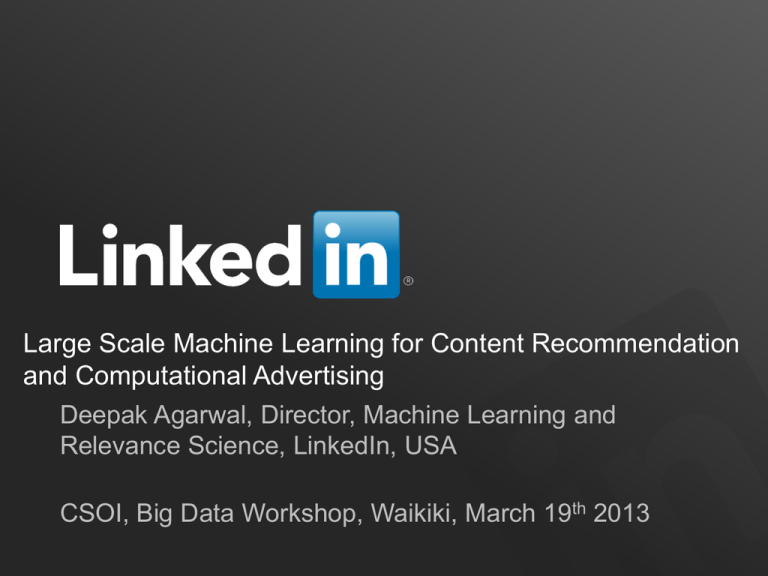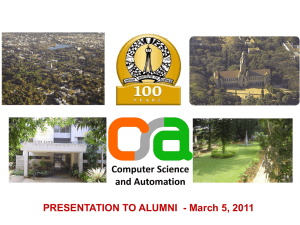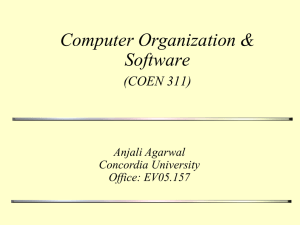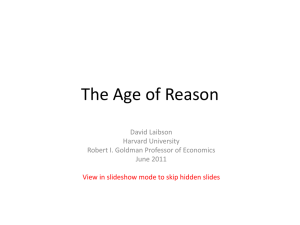X - Center for Science of Information
advertisement

Large Scale Machine Learning for Content Recommendation
and Computational Advertising
Deepak Agarwal, Director, Machine Learning and
Relevance Science, LinkedIn, USA
CSOI, Big Data Workshop, Waikiki, March 19th 2013
Disclaimer
Opinions expressed are mine and in no way
represent the official position of LinkedIn
Material inspired by work done at LinkedIn and
Yahoo!
CSOI WORKSHOP,, AGARWAL, 2013
Main Collaborators: several others at both Y! and
LinkedIn
I won’t be here without them, extremely lucky to work with such
talented individuals
Bee-Chung Chen
Jonathan Traupman
Liang Zhang
Nagaraj Kota
Bo Long
Paul Ogilvie
CSOI WORKSHOP,, AGARWAL, 2013
Item Recommendation problem
Arises in advertising and content
Serve the “best” items (in different
contexts) to users in an automated
fashion to optimize long-term
business objectives
Business Objectives
User engagement, Revenue,…
CSOI WORKSHOP,, AGARWAL, 2013
LinkedIn Today: Content Module
Objective: Serve content to maximize engagement
metrics like CTR (or weighted CTR)
CSOI WORKSHOP,, AGARWAL, 2013
Similar problem:
Content recommendation on Yahoo! front page
Today module
F1
F2
F3
F4
Recommend content links
(out of 30-40, editorially
programmed)
4 slots exposed, F1 has
maximum exposure
Routes traffic to other Y!
properties
CSOI WORKSHOP,, AGARWAL, 2013
LinkedIn Ads: Match ads to users visiting LinkedIn
CSOI WORKSHOP,, AGARWAL, 2013
Right Media Ad Exchange: Unified Marketplace
Bids $0.75 via Network…
Bids $0.50
Bids $0.60
Ad.com
AdSense
Bids $0.65—WINS!
Has ad
impression
to sell -AUCTIONS
… which becomes
$0.45 bid
Match ads to page views on publisher sites
CSOI WORKSHOP,, AGARWAL, 2013
High level picture
Server
http request
User Interacts
e.g. click,
does nothing
Item
Recommendation
system: thousands
of computations in
sub-seconds
Machine Learning
Models Updated in
Batch mode: e.g. once every
30 mins
CSOI WORKSHOP,, AGARWAL, 2013
High level overview: Item Recommendation System
Updated in batch:
Activity, profile
Pre-filter
SPAM,editorial,,..
Feature extraction
NLP, cllustering,..
User Info
Item Index
Id, meta-data
ML/
Statistical
Models
Score Items
P(Click), P(share),
Semantic-relevance
score,….
User-item interaction
Data: batch process
Rank Items:
sort by score (CTR,bid*CTR,..)
combine scores using Multi-obj optim,
Threshold on some scores,….
CSOI WORKSHOP,, AGARWAL, 2013
ML/Statistical models for scoring
Several days
Right Media Ad exchange
LinkedIn Ads
Few days
Few hours
LinkedIn Today
Yahoo! Front Page
100
Traffic volume
1000
100k
1M
100M
Number of items
Scored by ML
CSOI WORKSHOP,, AGARWAL, 2013
Summary of Machine learning deployments
Yahoo! Front page Today Module (2008-2011): 300% improvement
in click-through rates
– Similar algorithms delivered via a self-serve platform, adopted by
several Yahoo! Properties (2011): Significant improvement in
engagement across Yahoo! Network
Fully deployed on LinkedIn Today Module (2012): Significant
improvement in click-through rates (numbers not revealed due to
reasons of confidentiality)
Yahoo! RightMedia exchange (2012): Fully deployed algorithms to
estimate response rates (CTR, conversion rates). Significant
improvement in revenue (numbers not revealed due to reasons of
confidentiality)
LinkedIn self-serve ads (2012): Tests on large fraction of traffic
shows significant improvements. Deployment in progress.
CSOI WORKSHOP,, AGARWAL, 2013
Broad Themes
Curse of dimensionality
– Large number of observations (rows), large number of potential
features (columns)
– Use domain knowledge and machine learning to reduce the “effective”
dimension (constraints on parameters reduce degrees of freedom)
I will give examples as we move along
We often assume our job is to analyze “Big Data” but we often
have control on what data to collect through clever experimentation
– This can fundamentally change solutions
Think of computation and models together for Big data
Optimization: What we are trying to optimize is often complex, ML
models to work in harmony with optimization
– Pareto optimality with competing objectives
CSOI WORKSHOP,, AGARWAL, 2013
Statistical Problem
Rank items (from an admissible pool) for user visits in
some context to maximize a utility of interest
Examples of utility functions
– Click-rates (CTR)
– Share-rates (CTR* [Share|Click] )
– Revenue per page-view = CTR*bid (more complex due to
second price auction)
CTR is a fundamental measure that opens the door to a
more principled approach to rank items
Converge rapidly to maximum utility items
– Sequential decision making process (explore/exploit)
CSOI WORKSHOP,, AGARWAL, 2013
LinkedIn Today, Yahoo! Today Module:
Choose Items to maximize CTR
This is an “Explore/Exploit” Problem
Algorithm selects
User i visits
with
user features
(e.g., industry,
behavioral features,
Demographic
features,……)
item j from a set of candidates
(i, j) : response yij
(click or not)
Which item should we select?
The item with highest predicted CTR
An item for which we need data to
predict its CTR
Exploit
Explore
CSOI WORKSHOP,, AGARWAL, 2013
The Explore/Exploit Problem (to maximize CTR)
Problem definition: Pick k items from a pool of N for a large number
of serves to maximize the number of clicks on the picked items
Easy!? Pick the items having the highest click-through rates
(CTRs)
But …
– The system is highly dynamic:
Items come and go with short lifetimes
CTR of each item may change over time
– How much traffic should be allocated to explore new items to achieve
optimal performance ?
Too little Unreliable CTR estimates due to “starvation”
Too much Little traffic to exploit the high CTR items
CSOI WORKSHOP,, AGARWAL, 2013
Y! front Page Application
Simplify: Maximize CTR on first slot (F1)
Item Pool
– Editorially selected for high quality and brand image
– Few articles in the pool but item pool dynamic
CSOI WORKSHOP,, AGARWAL, 2013
CTR
CTR Curves of Items on LinkedIn Today
CSOI WORKSHOP,, AGARWAL, 2013
Impact of repeat item views on a given user
Same user is shown an item multiple times (despite not clicking)
CSOI WORKSHOP,, AGARWAL, 2013
Simple algorithm to estimate most popular item with
small but dynamic item pool
Simple Explore/Exploit scheme
– % explore: with a small probability (e.g. 5%), choose an
item at random from the pool
– (100−)% exploit: with large probability (e.g. 95%),
choose highest scoring CTR item
Temporal Smoothing
– Item CTRs change over time, provide more weight to recent
data in estimating item CTRs
Kalman filter, moving average
Discount item score with repeat views
– CTR(item) for a given user drops with repeat views by some
“discount” factor (estimated from data)
Segmented most popular
– Perform separate most-popular for each user segment
CSOI WORKSHOP,, AGARWAL, 2013
Time series Model: Kalman filter
Dynamic Gamma-Poisson: click-rate evolves over time in a
multiplicative fashion
Estimated Click-rate distribution at time t+1
– Prior mean:
– Prior variance:
High CTR items more adaptive
CSOI WORKSHOP,, AGARWAL, 2013
More economical exploration? Better bandit solutions
Consider two armed problem
p1
>
p2
(unknown payoff
probabilities)
The gambler has 1000 plays, what is the best way to experiment ?
(to maximize total expected reward)
This is called the “multi-armed bandit” problem, have been studied for a long time.
Optimal solution: Play the arm that has maximum potential of being good
Optimism in the face of uncertainty
CSOI WORKSHOP,, AGARWAL, 2013
Item Recommendation: Bandits?
Two Items: Item 1 CTR= 2/100 ; Item 2 CTR= 250/10000
– Greedy: Show Item 2 to all; not a good idea
– Item 1 CTR estimate noisy; item could be potentially better
Probability density
Invest in Item 1 for better overall performance on average
Item 2
Item 1
CTR
– Exploit what is known to be good, explore what is potentially good
CSOI WORKSHOP,, AGARWAL, 2013
Bayes 2x2: Two items, two intervals
now N0 views
Two time intervals t {0, 1}
Two items
t=0
N1 views
time
t=1
Decide: x
– Certain item with CTR q0 and q1, Var(q0) = Var(q1) = 0
– Uncertain item i with CTR p0 ~ Beta(a, b)
Interval 0: What fraction x of views to give to item i
– Give fraction (1x) of views to the certain item
– Let c ~ Binomial(p0, xN0) denote the number of clicks on item i
Interval 1: Always give all the views to the better item
– Give all the views to item i iff E[p1 | c, x] > q1
Find x that maximizes the expected total number of clicks
24
CSOI WORKSHOP,, AGARWAL, 2013
Bayes 2x2 Optimal Solution
Estimated CTR
Expected total number of clicks
Certain item: q0, q1
Uncertain item: p
ˆ 0 , pˆ1 ( x, c)
N 0 ( xpˆ 0 (1 x)q0 ) N1 Ec| x [max{pˆ1 ( x, c), q1}]
N 0 q0 N1q1 N 0 x( pˆ 0 q0 ) N1Ec| x [max{pˆ1 ( x, c) q1 , 0}]
E[#clicks] if we
always show the
certain item
Gain(x, q0, q1)
Gain of exploring the uncertain item using x
Gain(x, q0, q1) = Expected number of additional clicks if we explore
the uncertain item with fraction x of views in interval 0, compared to a
scheme that only shows the certain item in both intervals
Goal: argmaxx Gain(x, q0, q1)
25
CSOI WORKSHOP,, AGARWAL, 2013
Normal Approximation
Assume pˆ1 ( x, c) is approximately normal
q1 pˆ 0
q1 pˆ 0
1
( pˆ 0 q1 )
Gain( x, q0 , q1 ) N 0 x( pˆ 0 q0 ) N1 1 ( x)
1 ( x)
1 ( x)
pˆ 0 Ec|x [ pˆ1 ( x, c)] a /(a b)
xN0
ab
12 ( x) Var[ pˆ1 ( x, c)]
(a b xN0 ) (a b) 2 (1 a b)
After the normal approximation, the Bayesian optimal
solution x can be found in time O(log N0)
26
CSOI WORKSHOP,, AGARWAL, 2013
Gain
Gain as a function of xN0
xN0: Number of views given to the uncertain item
27 at t=0
CSOI WORKSHOP,, AGARWAL, 2013
Optimal number of views for
exploring the uncertain item
Optimal xN0 as a function of prior size
Prior effective sample size of the uncertain28
item
CSOI WORKSHOP,, AGARWAL, 2013
Bayes K2: K Items, Two Stages
K items
– pi,t: CTR of item i, pi,t ~ P(i,t).
– Let t = [1,t, … K,t]
– (i,t) = E[pi,t]
now N0 views
Prior 0
t=0
N1 views
t=1
1
Decide: xi,0
time
Decide: xi,1(1)
Stage 0: Explore each item to refine its CTR estimate
– Give xi,0N0 page views to item i
Stage 1: Show the item with the highest estimated CTR
– Give xi,1(1)N1 page views to item i
Find xi,0 and xi,1, for all i, that
– max {i N0xi,0(i,0) + i N1E1[xi,1(1)(i,1)]}
– subject to i xi,0 = 1, and i xi,1(1) = 1, for every possible 1
29
CSOI WORKSHOP,, AGARWAL, 2013
Bayes K2: Relaxation
Optimization problem
– maxx {i N0xi,0(i,0) + i N1E1[xi,1(1)(i,1)]}
– subject to i xi,0 = 1, and i xi,1(1) = 1, for every possible 1
Relaxed optimization
– maxx { i N0xi,0(i,0) + i N1E1[xi,1(1)(i,1)] }
– subject to i xi,0 = 1 and E1[ i xi,1(1) ] = 1
Apply Lagrange multipliers
– Separability: Fixing the multiplier values, the relaxed bayes K2
problem now becomes K independent bayes 22 problems
(where the CTR of the certain item is the multiplier)
– Convexity: The objective function is convex in the multipliers
30
CSOI WORKSHOP,, AGARWAL, 2013
General Case
The Bayes K2 solution can be extended to including
item lifetimes
Non-stationary CTR is tracked using dynamic models
– E.g., Kalman filter, down-weighting old observations
Extensions to personalized recommendation
– Segmented explore/exploit: Partition user-feature space into
segments (e.g., by a decision tree), and then explore/exploit
most popular stories for each segment
– First cut solution to Bayesian explore/exploit with regression
models
31
CSOI WORKSHOP,, AGARWAL, 2013
Experimental Results
One month Y! Front Page data
– 1% bucket of completely randomized data
– This data is used to provide item lifetimes, the number page
view in each interval, and the CTR of each item over time,
based on which we simulate clicks
– 16 items per interval
Performance metric
– Let S denote a serving scheme
– Let Opt denote the optimal scheme given the true CTR of each
item
– Regret = (#click(Opt) #clicks(S)) / #clicks(Opt)
32
CSOI WORKSHOP,, AGARWAL, 2013
Y! Front Page data (16 items per interval)
33
CSOI WORKSHOP,, AGARWAL, 2013
More Details on the Bayes Optimal Solution
Agarwal, Chen, Elango. Explore-Exploit Schemes for Web Content
Optimization, ICDM 2009
– (Best Research Paper Award)
CSOI WORKSHOP,, AGARWAL, 2013
Explore/Exploit with large item pool/personalized
recommendation
Obtaining optimal solution difficult in practice
Heuristic that is popularly used:
– Reduce dimension through a supervised learning approach
that predicts CTR using various user and item features for
“exploit” phase
– Explore by adding some randomization in an optimistic way
Widely used supervised learning approach
– Logistic Regression with smoothing, multi-hierarchy smoothing
Exploration schemes
– Epsilon-greedy, restricted epsilon-greedy, Thompson sampling, UCB
CSOI WORKSHOP,, AGARWAL, 2013
DATA
CONTEXT
Select Item j with item covariates Zj
(keywords, content categories, ...)
User i
visits
(User, context)
covariates xit
(i, j) : response yij
(click/no-click)
(profile information, device id,
first degree connections,
browse information,…)
CSOI WORKSHOP,, AGARWAL, 2013
Illustrate with Y! front Page Application
Simplify: Maximize CTR on first slot (F1)
Article Pool
– Editorially selected for high quality and brand image
– Few articles in the pool but article pool dynamic
We want to provide personalized recommendations
– Users with many prior visits see recommendations “tailored” to
their taste, others see the best for the “group” they belong to
CSOI WORKSHOP,, AGARWAL, 2013
Types of user covariates
Demographics, geo:
– Not useful in front-page application
Browse behavior: activity on Y! network ( xit )
– Previous visits to property, search, ad views, clicks,..
– This is useful for the front-page application
Latent user factors based on previous clicks on the
module ( ui )
– Useful for active module users, obtained via factor
models(more later)
Teases out module affinity that is not captured through other user
information, based on past user interactions with the module
CSOI WORKSHOP,, AGARWAL, 2013
Approach: Online + Offline
Offline computation
– Intensive computations done infrequently (once
a day/week) to update parameters that are less
time-sensitive
Online computation
– Lightweight computations frequent (once every 5-10
minutes) to update parameters that are timesensitive
– Exploration also done online
CSOI WORKSHOP,, AGARWAL, 2013
Online computation: per-item online logistic regression
For item j, the state-space model is
Item coefficients are update online via Kalman-filter
CSOI WORKSHOP,, AGARWAL, 2013
Explore/Exploit
Three schemes (all work reasonably well for the
front page application)
– epsilon-greedy: Show article with maximum posterior
mean except with a small probability epsilon, choose an
article at random.
– Upper confidence bound (UCB): Show article with
maximum score, where score = post-mean + k. post-std
– Thompson sampling: Draw a sample (v,β) from posterior
to compute article CTR and show article with maximum
drawn CTR
CSOI WORKSHOP,, AGARWAL, 2013
Computing the user latent factors( the u’s)
Computing user latent factors
– This is computed offline once a day using
retrospective (user,item) interaction data for last
X days (X = 30 in our case)
– Computations are done on Hadoop
CSOI WORKSHOP,, AGARWAL, 2013
Factorization Methods
Matrix factorization
– Models each user/item as a vector of factors (learned from
data)
K << M, N
M = number of users
N = number of items
rating that user i
gives item j
yij ~
k uik v jk uiv j
factor vector of user i
Y ~ U
M N
V
M K K N
factor vector of item j
item j
user i
ui’ui = (1,2)
user i
V
item j
vj
Y
vj = (1, -1)
43
U
CSOI WORKSHOP,, AGARWAL, 2013
How to Handle Cold Start?
Matrix factorization provides no factors for new users/items
Simple idea [KDD’09]
– Predict their factor values based on given features (not learnt)
For new user i, predict ui based on xi (user feature vector)
ui
~
G xi
Example features
G
factor vector
of user i
regression
coefficient matrix
isFemale
isAge0-20
…
isInBayArea
…
xi : feature vector of user i
44
CSOI WORKSHOP,, AGARWAL, 2013
Full Specification of RLFM
Regression-based Latent Factor Model
rating that user i
gives item j
yij ~ b( xij ) i jui v j
• Bias of user i:
xi = feature vector of user i
xj = feature vector of item j
xij = feature vector of (i, j)
i g ( xi ) i , i ~ N (0, 2 )
b j = d(Z j )+ e bj , e bj ~ N(0, s b2 )
u
u
2
• Factors of user i:u = G(x )+ e ,
ei ~ N(0, s u I)
i
i
i
• Popularity of item j:
• Factors of item j:
v j = D(Z j )+ e vj ,
e vj ~ N(0, s v2 I)
b, g, d, G, D are regression functions
Any regression model can be used here!!
45
CSOI WORKSHOP,, AGARWAL, 2013
Role of shrinkage (consider Guassian for
simplicity)
For new user/article, factor estimates based on
covariates
unew = Gx
user
new
, vnew = DZ
item
new
For old user, factor estimates
E(ui | Rest) = (l I + å v j v ) (lGx
' -1
j
jÎNi
user
i
+ å yij v j )
jÎNi
Linear combination of prior regression function
and user feedback on items
CSOI WORKSHOP,, AGARWAL, 2013
Estimating the Regression function via EM
Maximize
(
ij
f (u i , v j , Data ) g (u i , G ) g ( v j , D)) du i dv j
i
j
i
j
Integral cannot be computed in closed form,
approximated by Monte Carlo using Gibbs Sampling
For logistic, we use ARS (Gilks and Wild) to sample the
latent factors within the Gibbs sampler
CSOI WORKSHOP,, AGARWAL, 2013
Scaling to large data on via distributed
computing (e.g. Hadoop)
Randomly partition by users
Run separate model on each partition
– Care taken to initialize each partition model with
same values, constraints on factors ensure
“identifiability of parameters” within each partition
Create ensembles by using different user partitions,
average across ensembles to obtain estimates of
user factors and regression functions
– Estimates of user factors in ensembles uncorrelated,
averaging reduces variance
CSOI WORKSHOP,, AGARWAL, 2013
Data Example
1B events, 8M users, 6K articles
Offline training produced user factor ui
Our Baseline: logistic without user feature ui
lgt(pijt ) = x b jt
'
it
Overall click lift by including ui: 9.7%,
Heavy users (> 10 clicks last month): 26%
Cold users (not seen in the past): 3%
CSOI WORKSHOP,, AGARWAL, 2013
Click-lift for heavy users
CTR LIFT Relative to NO ui
Logistic Model
CSOI WORKSHOP,, AGARWAL, 2013
Multiple Objectives: An example in Content
Optimization
Recommender
EDITORIAL
content
Clicks on FP links influence
downstream supply distribution
AD SERVER
DISPLAY
ADVERTISING Revenue
Downstream
engagement
(Time spent)
CSOI WORKSHOP,, AGARWAL, 2013
Multiple Objectives
What do we want to optimize?
One objective: Maximize clicks
But consider the following
– Article 1: CTR=5%, utility per click = 5
– Article 2: CTR=4.9%, utility per click=10
By promoting 2, we lose 1 click/100 visits, gain 5 utils
If we do this for a large number of visits --- lose some clicks but
obtain significant gains in utility?
– E.g. lose 5% relative CTR, gain 40% in utility (e.g revenue, time spent)
CSOI WORKSHOP,, AGARWAL, 2013
An example of Multi-Objective Optimization
(Details: Agarwal et al, SIGIR 2012)
Lagrange multiplier
CSOI WORKSHOP,, AGARWAL, 2013
Example: Yahoo! Front Page Application
Personalized
55
CSOI WORKSHOP,, AGARWAL, 2013
Now to Computational Advertising
Background on Advertising
Background on Display Advertising
– Guaranteed Delivery : Inventory sold in futures market
– Spot Market --- Ad-exchange, Real-time bidder (RTB)
Statistical Challenges with examples
CSOI WORKSHOP,, AGARWAL, 2013
The two basic forms of advertising
1. Brand advertising
– creates a distinct favorable image
2. Direct-marketing
–
Advertising that strives to solicit a "direct
response”: buy, subscribe, vote, donate, etc,
now or soon
57
CSOI WORKSHOP,, AGARWAL, 2013
Brand advertising …
58
CSOI WORKSHOP,, AGARWAL, 2013
Sometimes both Brand and Performance
59
CSOI WORKSHOP,, AGARWAL, 2013
Web Advertising
There are lots of ads on the web …
100s of billions of advertising dollars
spent online per year (e-marketer)
60
Ads
Content
Pick
ads
Ad Network
Advertisers
Online advertising: 6000 ft. Overview
User
Content
Provider
Examples:
Yahoo, Google,
MSN, RightMedia,
…
CSOI WORKSHOP,, AGARWAL, 2013
Web Advertising: Comes in different flavors
Sponsored (“Paid” ) Search
– Small text links in response to query to a search engine
Display Advertising
– Graphical, banner, rich media; appears in several contexts like
visiting a webpage, checking e-mails, on a social network,….
– Goals of such advertising campaigns differ
Brand Awareness
Performance (users are targeted to take some action, soon)
– More akin to direct marketing in offline world
CSOI WORKSHOP,, AGARWAL, 2013
Paid Search: Advertise Text Links
CSOI WORKSHOP,, AGARWAL, 2013
Display Advertising: Examples
CSOI WORKSHOP,, AGARWAL, 2013
Display Advertising: Examples
CSOI WORKSHOP,, AGARWAL, 2013
LinkedIn company follow ad
CSOI WORKSHOP,, AGARWAL, 2013
Brand Ad on Facebook
CSOI WORKSHOP,, AGARWAL, 2013
Paid Search Ads versus Display Ads
Paid Search
Display
Context (Query) important
Reaching desired audience
Small text links
Graphical, banner, Rich media
– Text, logos, videos,..
Performance based
– Clicks, conversions
Advertisers can cherry-pick
instances
Hybrid
– Brand, performance
Bulk buy by marketers
– But things evolving
Ad exchanges, Real-time
bidder (RTB)
CSOI WORKSHOP,, AGARWAL, 2013
Display Advertising Models
Futures Market (Guaranteed Delivery)
– Brand Awareness (e.g. Gillette, Coke, McDonalds,
GM,..)
Spot Market (Non-guaranteed)
– Marketers create targeted campaigns
Ad-exchanges have made this process efficient
– Connects buyers and sellers in a stock-market style market
Several portals like LinkedIn and Facebook have self-serve
systems to book such campaigns
CSOI WORKSHOP,, AGARWAL, 2013
Guaranteed Delivery (Futures Market)
Revenue Model: Cost per ad impression(CPM)
Ads are bought in bulk targeted to users based on
demographics and other behavioral features
GM ads on LinkedIn shown to “males above 55”
Mortgage ad shown to “everybody on Y! ”
Slots booked in advance and guaranteed
– “e.g. 2M targeted ad impressions Jan next year”
– Prices significantly higher than spot market
– Higher quality inventory delivered to maintain mark-up
CSOI WORKSHOP,, AGARWAL, 2013
Measuring effectiveness of brand advertising
"Half the money I spend on advertising is wasted; the trouble is, I don't know
which half." - John Wanamaker
Typically
– Number of visits and engagement on advertiser website
– Increase in number of searches for specific keywords
– Increase in offline sales in the long-run
How?
– Randomized design (treatment = ad exposure, control = no exposure)
– Sample surveys
– Covariate shift (Propensity score matching)
Several statistical challenges (experimental design, causal inference
from observational data, survey methodology)
CSOI WORKSHOP,, AGARWAL, 2013
Guaranteed delivery
Fundamental Problem: Guarantee impressions (with overlapping
inventory)
1. Predict Supply
Young
2. Incorporate/Predict Demand
US
3. Find the optimal allocation
2
4
1
• subject to supply and
demand constraints
3
2
LI
Homepage
2
si
1
Female
xij
dj
CSOI WORKSHOP,, AGARWAL, 2013
Example
Supply Pools
Young
US
2
3
4
2
1
2
1
LI
Female
Homepage
Supply Pools
US, Y, nF
Supply =
2
Price = 1
Demand
US & Y
(2)
US, Y, F
Supply =
3
Price = 5
How should we distribute
impressions from the supply pools to
satisfy this demand?
CSOI WORKSHOP,, AGARWAL, 2013
Example (Cherry-picking)
Cherry-picking:
Fulfill demands at least cost
Supply Pools
US, Y, nF
Supply =
2
Price = 1
(2)
Demand
US & Y
(2)
US, Y, F
Supply =
3
Price = 5
How should we distribute
impressions from the supply pools to
satisfy this demand?
CSOI WORKSHOP,, AGARWAL, 2013
Example (Fairness)
Cherry-picking:
Fulfill demands at least cost
Supply Pools
Fairness:
Equitable distribution of
available supply pools
US, Y, nF
Supply =
2
Cost = 1
(1)
(1)
Demand
US & Y
(2)
US, Y, F
Supply =
3
Cost = 5
Agarwal and Tomlin, INFORMS,
2010
Ghosh et al, EC, 2011
How should we distribute
impressions from the supply pools to
satisfy this demand?
CSOI WORKSHOP,, AGARWAL, 2013
The optimization problem
Maximize Value of remnant inventory (to be sold in spot market)
– Subject to “fairness” constraints (to maintain high quality of
inventory in the guaranteed market)
– Subject to supply and demand constraints
Can be solved efficiently through a flow program
Key statistical input: Supply forecasts
76
CSOI WORKSHOP,, AGARWAL, 2013
Various component of a
Guaranteed Delivery system
OFFLINE
COMPONENTS
Supply
forecasts
Demand
forecasts &
booked
inventory
Admission
Control
should the new
contract request
be admitted?
(solve VIA LP)
Field Sales
Team, sells
Advertisers
Products
(segments)
Contracts signed,
Negotiations involved
Pricing
Engine
CSOI WORKSHOP,, AGARWAL, 2013
ONLINE SERVING
Stochastic Supply
Contract Statistics
Stochastic Demand
Near Real
Time
Optimization
Allocation
Plan
(from LP)
Opportunity
On Line Ad
Serving
Ads
CSOI WORKSHOP,, AGARWAL, 2013
Spot Market
Unified Marketplace (Ad exchange)
Publishers, Ad-networks, advertisers participate together in a singe
exchange
Advertisers
Sports Accessories
Car Insurance
Online Education
submit ads to the network
Intermediaries
www.cars.com
display ads for the network
www.elearners.com
www.sportsauthority.com
Publishers
Clearing house for publishers, better ROI for advertisers, better
liquidity, buying and selling is easier
CSOI WORKSHOP,, AGARWAL, 2013
Overview: The Open Exchange
Bids $0.75 via Network…
Bids $0.50
Bids $0.60
Ad.com
AdSense
Bids $0.65—WINS!
Has ad
impression
to sell -AUCTIONS
… which becomes
$0.45 bid
Transparency and value
CSOI WORKSHOP,, AGARWAL, 2013
Unified scale: Expected CPM
Campaigns are CPC, CPA, CPM
They may all participate in an auction together
Converting to a common denomination
– Requires absolute estimates of click-through rates
(CTR) and conversion rates.
– Challenging statistical problem
CSOI WORKSHOP,, AGARWAL, 2013
Recall problem scenario on Ad-exchange
conversion
Response rates
(click, conversion,
ad-view)
Bids
Statistical
model
Select argmax f(bid, rate)
Click
Ads
Page
User
Publisher
Pick
best ads
Ad
Network
Advertisers
Auction
CSOI WORKSHOP,, AGARWAL, 2013
Statistical Issues in Conducting Auctions
f(bid, rate) (e.g. f = bid*rate)
– Response rates (Click-rate, conversion rate) to be estimated
High dimensional regression problem
F(y | o = (i, c, u), j)
Opportunity=(publisher, context, user)
ad
Response obtained via interaction among few heavy-tailed
categorical variables (opportunity and ad)
– Total levels for categorical variables : millions and changes over time
– Response rate: very small (e.g. 1 in 10k or less)
CSOI WORKSHOP,, AGARWAL, 2013
Data for Response Rate Estimation
Features
– User Xu : Declared, Inferred (e.g. based on tracking, could
have significant measurement error) (xud, xuf)
– Publisher Xi: Characteristics of publisher page
(e.g. Business news page? Related to Medicine industry? Other
covariates based on NLP of landing page)
– Context Xc: location where ad was shown,device, etc.
– Ad Xj: advertiser type, campaign keywords, NLP on ad
landing page
CSOI WORKSHOP,, AGARWAL, 2013
Building a good predictive model
We can build f(Xu, Xi, Xc, Xj ) to predict CTR
– Interactions important, high-dimensional regression problem
– Methods used (e.g. logistic regression with L2 penalty)
Billions of observations, hundreds of millions of covariates
(sparse)
Is this enough? Not quite
– Covariates not enough to capture interactions, modeling
residual interactions at resolution of ads/campaign important
Ephemeral features, warm start
– Variable dimension: New ads/campaigns routinely introduced,
old ones disappear (runs out of budget)
CSOI WORKSHOP,, AGARWAL, 2013
Exploiting hierarchical structure
Agarwal et al, KDD 2007, 2010,
2011
Model Setup
baseline
Po,j =
f( Xo
xj
) λij
residual
i
j
E = ∑( f(xi, xu,xc xj) (Expected clicks)
ij
u,c)
Sij ~ Poisson(Eij λij)
CSOI WORKSHOP,, AGARWAL, 2013
Hierarchical Smoothing of residuals
Assuming two hierarchies (Publisher and advertiser)
Advertiser
Pub type
Account-id
Pub
cell z = (i,j)
(
campaign
Ad
Sz, Ez, λz)
Advertiser
Pub type
Account-id
Pub
z
campaign
Ad
(Sz, Ez, λz)
CSOI WORKSHOP,, AGARWAL, 2013
Spike and Slab prior on random effects
Prior on node states: IID Spike and Slab prior
– Encourage parsimonious solutions
Several cell states have residual of 1
– Agarwal and Kota, KDD 2010, 2011
CSOI WORKSHOP,, AGARWAL, 2013
Accuracy: Average test log-likelihood
COARSE: Only Advertiser id in the model
FINE: Only ad-id in the model
Log 1,II,III: Different variations of logistic
CC
CSOI WORKSHOP,, AGARWAL, 2013
Model Parsimony
With spike and slab prior
Parsimony
data
#Parameters
#selected
CLICK
~16.5M
150K
CSOI WORKSHOP,, AGARWAL, 2013
Computation at serve time
At serve time (when a user visits a website), thousands of qualifying
ads have to be scored to select the top-k within a few milliseconds
Accurate but computationally expensive models may not satisfy
latency requirements
– Parsimony along with accuracy is important
Typical solution used: two-phase approach
– Phase 1: simpler but fast to compute model to narrow down the
candidates
– Phase 2: more accurate but more expensive model to select top-k
Important to keep this aspect in mind when building models
– Model approximation: Langford et al, NIPS 08, Agarwal et al, WSDM
2011
CSOI WORKSHOP,, AGARWAL, 2013
Need uncertainty estimates
Goal is to maximize revenue
– Unnecessary to build a model that is accurate everywhere,
more important to be accurate for things that matter!
– E.g. Not much gain in improving accuracy for low ranked ads
Explore/exploit
– Spend more experimental budget on ads that appear to be
potentially good (even if the estimated mean is low due to small
sample size)
CSOI WORKSHOP,, AGARWAL, 2013
Advanced advertising Eco-System
New technologies
– Real-time bidder: change bid dynamically, cherry-pick users
– Track users based on cookie information
– New intermediaries: sell user data (BlueKai,….)
– Demand side platforms: single unified platform to buy
inventories on multiple ad-exchanges
– Optimal bidding strategies for arbitrage
CSOI WORKSHOP,, AGARWAL, 2013
To Summarize
Display advertising is an evolving and multi-billion dollar industry
that supports a large swath of internet eco-system
Plenty of statistical challenges
–
–
–
–
–
–
–
High dimensional forecasting that feeds into optimization
Measuring brand effectiveness
Estimating rates of rare events in high dimensions
Sequential designs (explore/exploit) requires uncertainty estimates
Constructing user-profiles based on tracking data
Targeting users to maximize performance
Optimal bidding strategies in real-time bidding systems
New challenges
– Mobile ads, Social ads
At LinkedIn
– Job Ads, Company follows, Hiring solutions
CSOI WORKSHOP,, AGARWAL, 2013
Training Logistic Regression
Too much data to fit on a single machine
– Billions of observations, millions of features
A Naïve approach
– Partition the data and run logistic regression for each partition
– Take the mean of the learned coefficients
– Problem: Not guaranteed to converge to the model from single
machine!
Alternating Direction Method of Multipliers (ADMM)
– Boyd et al. 2011 (based on earlier work from the 70s)
– Set up a constraint that each partition’s coefficient = global consensus
– Solve the optimization problem using Lagrange Multipliers
CSOI WORKSHOP,, AGARWAL, 2013
Large Scale Logistic Regression via ADMM
Iteration 1
BIG DATA
Partition 1
Partition 2
Partition 3
Partition K
Logistic
Regression
Logistic
Regression
Logistic
Regression
Logistic
Regression
Consensus
Computation
CSOI WORKSHOP,, AGARWAL, 2013
Large Scale Logistic Regression via ADMM
Iteration 1
BIG DATA
Partition 1
Partition 2
Partition 3
Partition K
Logistic
Regression
Logistic
Regression
Logistic
Regression
Logistic
Regression
Consensus
Computation
CSOI WORKSHOP,, AGARWAL, 2013
Large Scale Logistic Regression via ADMM
Iteration 2
BIG DATA
Partition 1
Partition 2
Partition 3
Partition K
Logistic
Regression
Logistic
Regression
Logistic
Regression
Logistic
Regression
Consensus
Computation
CSOI WORKSHOP,, AGARWAL, 2013
Convergence Study (Avg Optimization Objective Score on Test)
-0.185
-0.190
-0.195
-0.200
Avg Test Loglik
-0.180
Convergence for ADMM
5
10
Iterations
15
20
CSOI WORKSHOP,, AGARWAL, 2013
Large Scale Logistic Regression via ADMM
Notation:
–
–
–
–
(A, b): data
xi: Coefficients for partition i
z: Consensus coefficient vector
r(z): penalty component such as ||z||2
Problem
l
ADMM
Per-partition
Regression
Consensus
Computation
CSOI WORKSHOP,, AGARWAL, 2013
ADMM in practice: Lessons learnt
Lessons and Improvements
– Initialization is very important
Use the mean of the partitions’ coefficients to start
Reduces number of iterations by about 50% relative to random start
– Adaptive step size (learning rate)
Exponential decay of learning rate balances global convergence with
exploration within partitions
– Together, these optimizations speed-up training time by 4x
CSOI WORKSHOP,, AGARWAL, 2013
Solution strategy for item-recommendation problem
Fit large scale logistic regression model on historic data to obtain
estimates of feature interactions (cold-start estimates)
– Caution: Include the fine-grained id-features (old items seen in the
past) in the model to avoid bias in cold-start estimates
Warm-start model updated frequently (e.g. every few hours,
minutes) using cold-start estimates as offset
– Dimension reduction: Factor models, multi-hierarchy smoothing,..
The cold-start model is updated more infrequently (e.g. once a day)
Introduce exploration (to avoid item starvation) by using heuristics
like epsilon-greedy, Thompson sampling, UCB
CSOI WORKSHOP,, AGARWAL, 2013
Summary
Large scale Machine Learning plays an important role in
computational advertising and content recommendation
Several such problems can be cast as explore/exploit
tradeoff
Estimating interactions in high-dimensional sparse data via
supervised learning important for efficient exploration and
exploitation
Scaling such models to Big Data is a challenging statistical
problem
Combining offline + online modeling with classical
explore/exploit algorithm is a good practical strategy
CSOI WORKSHOP,, AGARWAL, 2013
Feed Recommendation
CSOI WORKSHOP,, AGARWAL, 2013
Feed Recommendation
Content liquidity depends on the graph (Social)
Content can also be pushed by a publisher (LinkedIn)
We can slot ads (Advertising)
Multiple response types (clicks, shares, likes, comments)
Goal: Maximize Revenue and Engagement (Best Tradeoff)
CSOI WORKSHOP,, AGARWAL, 2013
Other challenges
3Ms: Multi-response, Multi-context modeling to optimize Multiple
Objectives
– Multi-response: Clicks, share, comments, likes,.. (preliminary work at
CIKM 2012)
– Multi-context: Mobile, Desktop, Email,..(preliminary work at SIGKDD
2011)
– Multi-objective: Tradeoff in engagement, revenue, viral activities
Preliminary work at SIGIR 2012, SIGKDD 2011
Scaling model computations at run-time to avoid latency issues
– Predictive Indexing (preliminary work at WSDM 2012)
CSOI WORKSHOP,, AGARWAL, 2013








